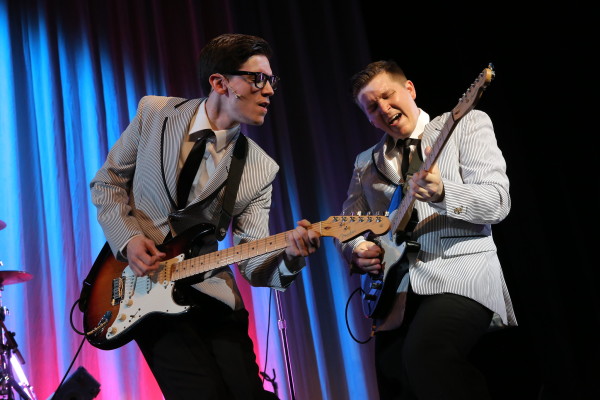Photo by JOAN MARCUS
Bucks County Playhouse’s production of Buddy: The Buddy Holly Story, currently in residence at the Kimmel Center, is a must-see for audiences looking for an authentic journey back to teenage America in the bobby-sox-and-soda-pop ‘50s. This seamless adaptation of the 1978 film The Buddy Holly Story, starring pre-drugs-and-insanity Gary Busey, manages to artfully re-create the life and tragically premature death of Charles Hardin “Buddy” Holley with arresting performances, imaginative staging, and an unblinking glimpse of the racial tensions of the time.
A quick history lesson for anyone who wasn’t a teenager in 1958: Buddy Holly was a ridiculously talented and innovative singer/songwriter/guitarist and rock n’ roll pioneer who skyrocketed to fame in the 1950s with a string of irresistible pop hits. Holly remains a central figure in the birth of rock and roll, think Elvis in Clark Kent glasses with a country twang. Sadly, he only enjoyed two years of worldwide fame before he met his demise in a plane crash in 1959. He was 22.
John Dewey uncannily channels Buddy Holly down to his nerdy-cool charisma and nasal Texan drawl. At first, I couldn’t tell if the vocals and instruments were live because they were just that good. I had to listen to Holly on Spotify in between acts to ensure that the vocals weren’t being lip synced. Bandmates Jerry Allison and Joe B. Mauldin, aka The Crickets, played by Zach Cossman and James David Larson, were hilarious and endearing foils to Holly. The verve and showmanship they put into the 27 tunes played throughout the show was remarkable with Larson turning in an acrobatic performance on upright bass while Cossman kept the show moving and upbeat with steady percussion.
A considerable difficulty that accompanies the adaptation of stories to the stage is the lack of space. The attention of audience members was often directed to different corners of the room as the voice of multiple narrators and strategic lighting drew their sights away from the main stage. The story called for starkly different stage setups. This was made possible by the narration which came in the form of radio hosts across the country and gave crew members time to make necessary changes to the set and seamlessly guide the story onwards. The audience also played an essential role, their engagement with the audience is what allowed the room to be transformed for historic recreations like Holly’s famed appearance at the Apollo Theater.
It was the production’s unflinching treatment of the racial tensions that comprised the dark side of the American 1950s that truly impressed me. It would have been very easy to romanticize the ignorance and institutionalized bigotry of the time and disregard the darker social forces that impacted Buddy’s career. Instead, Buddy draws attention to these issues, acknowledging the controversy surrounding Holly’s mixed race marriage to Maria Elena Santiago and his well-founded apprehension about being a white performer at the Apollo. Which is not to suggest that Buddy: The Buddy Holly Story is a historically-accurate bummer, far from it. The vast majority of the show’s nearly two hour run time gallops along with the same wholesome innocence and giddy joy that made songs like “Peggy Sue” and “That’ll Be The Day” timeless classics. — ERIN BLEWETT
THE BUDDY HOLLY STORY NOW PLAYING @ THE KIMMEL CENTER THRU JULY 9

